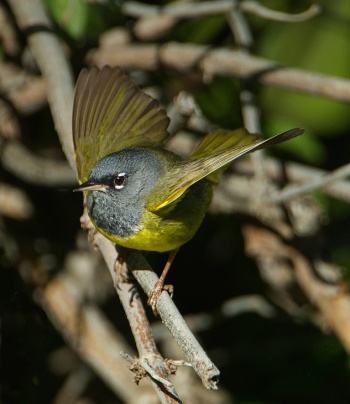- Geothlypis tolmiei
Oporornis tolmiei
Identification
13 cm; (5.25 ins)
- Olive-green upperparts
- Yellow underparts
- White crescents above and below the eyes
- Slate-grey hood with black lores
- Black upper breast
- Flesh-coloured lower mandible.
Female: similar but paler
- Winter adult has paler hood and less distinct eye-ring.
First winter birds
- Similar to adults with olive-grey back and wings, greenish underside and most of the same hood
- White throat area
- Thin pale to white supraloral
- Eye-ring is thin
- Hood color cleaner grey in male, more olive in female
- Gradually moults into full adult plumage
Similar Species
Mourning Warbler lacks the white eye crescents.
Hybrids between the 2 species occur where the range overlaps.
Distribution
Breeds in the western United States and Canada from southern Northwest Territories south to central California, Utah and Colorado, scattered populations south and east of regular range; wintering on the Pacific slope of Mexico.
Taxonomy
This is a monotypic species[1].
Subspecies monticola is not recognised by most authorities.
Hybridizes with Mourning Warbler where ranges overlap.
Formerly placed in genus Oporornis.
Habitat
Coniferous forest edges, burns, dense thickets, and streamside growth.
Behaviour
Breeding
May to August at up to 300m in dense understory along forest edges and clearings. The nest is a cup of plant stalks and grasses, lined with rootlets, hair and fine grasses, and concealed low down in a bush. 3-6 eggs are incubated for 11-13 days, young fledge after 8-9 days. Nests are only rarely parasitized by Brown-headed Cowbird.
Diet
Almost entirely insects and other arthropods, including beetles, caterpillars and leafhoppers. Forages low in dense shrub cover.
Vocalisation
- Song: 3-4 tchee notes in one pitch, then 2-3 more warbles teeoo notes at a lower pitch.
- Call: a hard shik or tsik; flight call is a penetrating tseep
References
- Clements, J. F., T. S. Schulenberg, M. J. Iliff, D. Roberson, T. A. Fredericks, B. L. Sullivan, and C. L. Wood. 2017. The eBird/Clements checklist of birds of the world: v2017, with updates to August 2017. Downloaded from http://www.birds.cornell.edu/clementschecklist/download/
- Avibase
- Dunn, Jon; Garrett, Kimball. 1997. A Field Guide to Warblers of North America. Boston: Houghton Mifflin Company. ISBN 9780395783214
- Handbook of the Birds of the World Alive (retrieved April 2016)
- Avibase
- Birdforum thread discussing the id of a young MacGillivray's Warbler
Recommended Citation
- BirdForum Opus contributors. (2025) MacGillivray's Warbler. In: BirdForum, the forum for wild birds and birding. Retrieved 2 May 2025 from https://www.birdforum.net/opus/MacGillivray%27s_Warbler
External Links
Search the Gallery using the scientific name:
GSearch checked for 2020 platform.1





